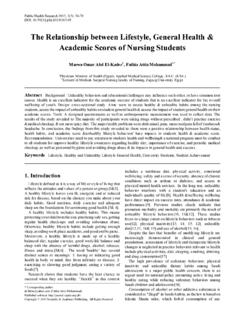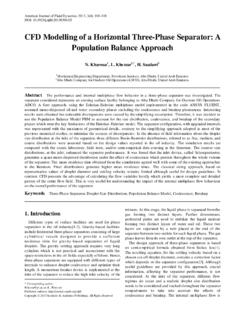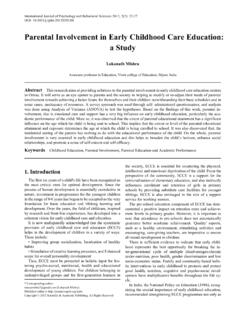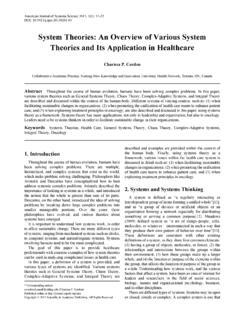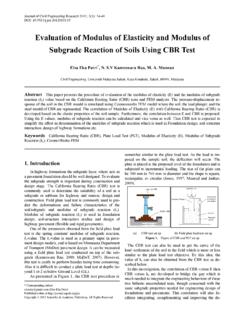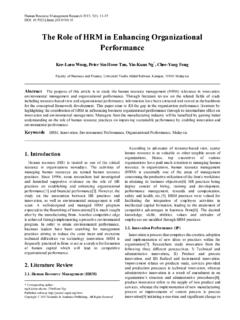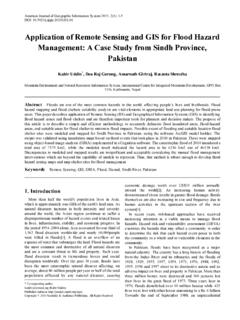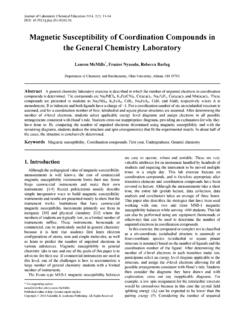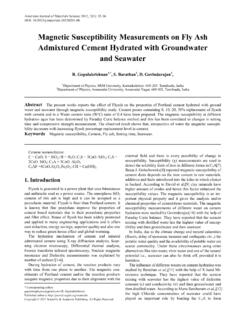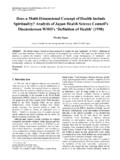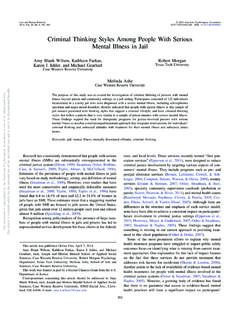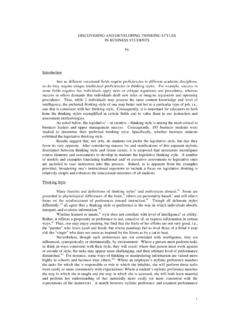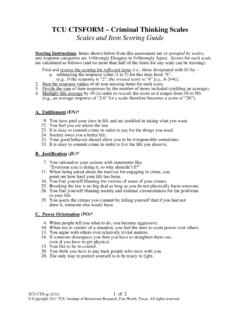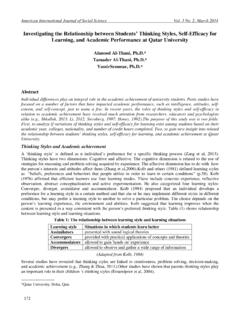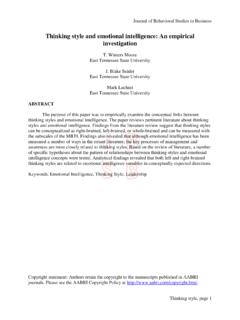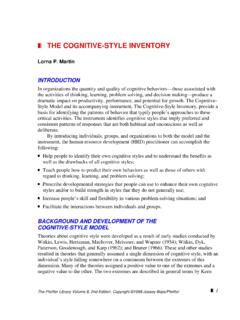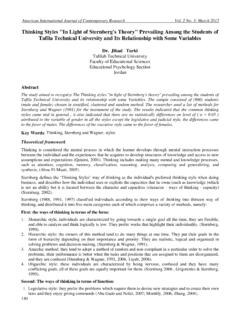Transcription of Learning and Thinking Styles Based on Whole Brain Theory ...
1 Research in Neuroscience 2013, 2(1): 1-10 DOI: Learning and Thinking Styles Based on Whole Brain Theory in Relation to Sensory-Motor Integration Ahmad Mohame d Awad Al Ghraibe h*, Abdullah Ahme d Al-Zahrani Dep artment of Psy chology , College of Edu cation, Kin g Saud University, Riy adh 1451, PO Box 2458, Saudi Arab ia Abs t rac t The study aims to explore learn ing and Thinking Styles Based on Whole Brain Theory ; and their relationship with sensory-motor integration. It also explores the correlat ions between variables. Two tests were used to explore the correlations between the two variables ( Learning and Thinking Styles Based on Whole Brain Theory test and sensory-motor integration test). Tests were admin istered to discover whether the variables differ accord ing to gender and age groups.
2 Validity and reliab ility of the tests were insured. The study was conducted Based on a stratified random (cluster) sample of (753) male and female students. The participants are (12-16) years old, enro lled in 13 public schools (7 male and 6 female schools) at Irbid first directorate. The study reveals significant correlations between both (Q_D0Fi) and (Q_C1 Fii ) w it h sensory-motor integration test due to gender differences in favour of fe ma les . Ke y wo r ds Hemispheres , Bra in, Sens ory-Motor Integration, Learning and Thinking Styles 1. Introduction People tend to rely on one side of the Brain mo re than the other in information processing. This reliance is referred to as dominancy which may appear among people in the style adopted in the process of learn ing and Thinking . John Jackson invents hemispheric dominancy as he proposes the idea of the leading hemispheres of which Brain dominance is derived.
3 Diffe rent researchers verify the importance of this phenomenon in the process of Thinking and Learning , through studying correlations between Thinking and learn ing Styles with hemispheres functions[1]. The right hemisphere controls sensory-mo t o r act iv it ies o f the left side of the body, wh ile the right side activities are controlled main ly by the left hemisphere. Therefore the right hand, leg or ear stimuli are processed main ly in the left hemisphere whereas the left hand, leg or ear stimuli a re processed in the right hemisphere[2]. Eyes are controlled in a more co mplex way. The v isual field is div ided. Each eye transfers information to both hemispheres. In this process, the left eye field vision is recognized in the right hemisphere, and the right eye field vision is recognized in t h e le ft hemisphere.
4 [3] Fac ial muscles are like ly to be the first recalled to function. Then fo llo ws the muscles of the upper part of the body, and lo wer part muscles respectively. F in al ly , muscles of the Whole body are triggered[4]. Whole Brain Theory offers an approach for understanding * Corresponding author: (Ahmad Mohamed Aw ad Al Ghraibeh) Published online at Copyright 2013 Scientific & Academic Publishing. All Rights Reserved Brain functions through Four Quadrant Model. The model presents four modes of Learning and Thinking Based on Whole - Brain Theory . The model focuses on three basic ideas. First, Styles are not featured as good or bad, nor as right or wrong. Second, the style shows a preference for mental activity wh ich is quite different fro m the efficiency of performing that activity.
5 Third, Styles tend to be constant over time. Herrmann[5] div ides these Styles as Left Mode Thinking Processes which is divided into two parts. First, Upper Left Quadrant or what is referred to as Q_A. This style features the person preference of act ivities such as analyzing, dissecting, figuring out, solving problems logically, and getting facts. In making decisions, the person relies on logic Based on certain assumptions, combined with the ability to perceive, verbalize, and express things precisely. Second, the Lower Left Quadrant is symbolized by (Q_ B). A Q_B features a person who has rules, adheres to them and to what has worked before. However; he fights progress and does not accept the change. His effic iency has to do with making sure things are done on time and in a correct manner.
6 Herrmann further focuses on one thing at a time then moves to the other. Moreover h is interest is always focused on answers. Right Mode Thinking p rocesses include two parts. First, the Lower Right Quadrant, which is referred to as Q_ C. A Q_C, is featured as a sponge that sops experience. As Q_A, Q_C is preoccupied with facts associated with emotional trends, the person of this type recognizes when the mood change occurs then he responds to it calmly. He recognizes e xperience as a fact. There is no time for logic or for theoretical perspective for him. Second, the Upper Right Quadrant, referred to as Q_D, features an ambiguous person. The speech of such an ambiguous person relies on metaphors 2 Ahmad M ohamed Awad Al Ghraibeh e t al.: Learn in g and Thinkin g Sty les Based on Whole Brain Theory in Relation to Sensory-M otor Integration without providing translations of how these metaphors help in clarifying what he says[5].
7 Fro m a functional view, some obvious differences between the two hemispheres are related to the motor control. The right hemisphere controls the movement of the left part of the body, and the left hemisphere controls the movements of the right part of the body[6], [7]. Few studies correlate the rig ht hemisphere with motor skills. W h ile s o me researchers correlate motor skills with the left hemisphere, others tend to correlate the two hemispheres with motor skills. The right hemisphere is considered an important factor in determining the right hand skill for who uses it fo r major motor skills, wh i le spatial and touch skills are mo re correlated with the left hemisphere[8]. Sensory - Motor Integration is characterized by the integration of activities, and it is controlled by different parts (limbs) and senses of the body especially the vision.
8 It is the ability to control one or more parts of the body when used in complex movements to integrate parts movements in doing a motor activity characterized by s moothness and success. It may also include some sort of integration between body parts especially the sense of vision. A clear examp le of such integration is what happens between the hand and eye or between the leg and eye[9]. When considering senses roles in Learning , we should not be concerned with the way these roles help children to learn s kills and information. However, it is preferab le to focus on the developmental impact on the child's ability to perform specific tasks, as well as, the impact of classroom activities on the development and integration of sensors. Sensory and motor systems form the basis of subsequent development of both typical verbal and abstract Thinking .
9 Reading and writing requires a comp lex coordination between these two systems. Children who do not achieve sufficient integration between the two systems face motor and sensory Learning d iff icu lt ies[1 0],[11]. In schools, s p ecialis t s often overlook the sense of movement as a component of Learning ; it is usually beyond cognition. When one is not sure of a word spelling, he relies upon the sense of movement to guide his hand (although one may also rely on visual checking to see if the word looks correct). When one uses hands to explain something, he uses Thinking Based on a sense of movement and verbal Thinking [1 2]. Teachers in primary education direct children not to move in class, and not to move their eyes away fro m the blackboard. The teachers ignore the fact that sight is b as ically associated with the movement, and that the eye is not fully adapted with collagen fibers.
10 Although eye movement appears simple or physically s mall, it has a large impact on the way in which a child accesses knowledge and cognition. Movement awakes many mental abilities and energizes them. It also integrates new information and experience in the neural networks and firms it. Additionally it is vital for every movement t h at ref lect s in d iv id u al Learning and understanding of self[1 3]. Intelligence e xists in the cells d istributed throughout the body in addition to the b rain[14]. For the purpose of this research, there are three basic points according to Ratey[15] that exp lain the correlation: Movement is essential for the existence of the Brain in particular. In fact organism that moves from one place to another is in need for the Brain .
